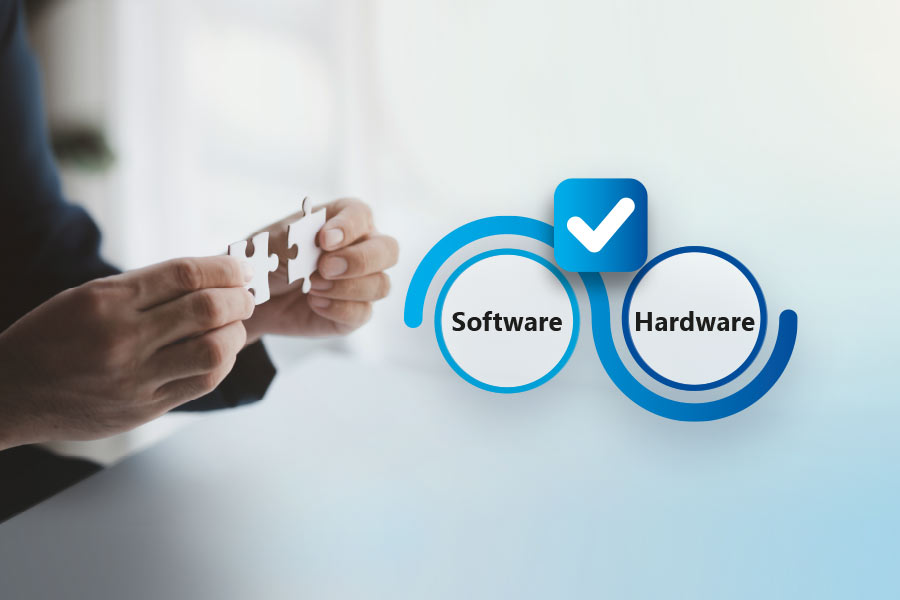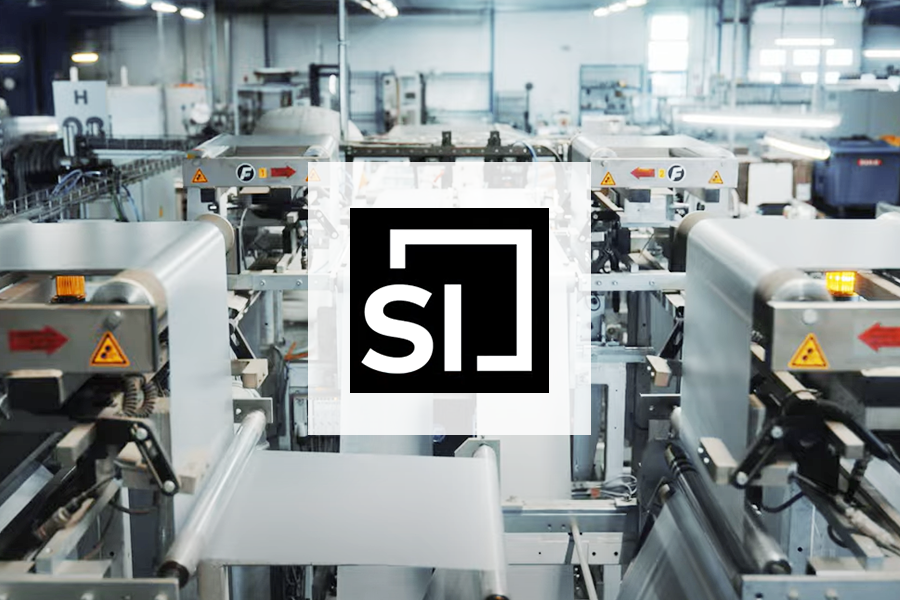A Look at the New Products
pvaPRO is currently a dashboard add-on that complements the existing Manufacturing Execution System (MES) FASTEC 4 PRO and will evolve into a fully functional MES in the future. smartOEE is a plug & play solution that enables a fast and cost-effective entry into MES—minimal effort, maximum results. With FASTedge, companies receive hardware tailored to the software, providing everything from a single source. The FASTedge Box connects the shop floor and the cloud. Through the FASTedge SFT15 touch terminal, production staff can enter data directly at the machines. The FASTedge SFH10, as a tablet, is ideal for mobile use in production.
Entwicklungsschritt 1: Zentralisierung
Like many other industries, the MES market has undergone significant changes. A few years ago, providers sold large systems consisting of many interconnected functions. The advantage of these monolithic solutions is that everything works seamlessly together. However, upgrades become increasingly complex. Companies, on the other hand, benefit from modular approaches: following a building-block principle, they can select only the components they actually need and pay only for their specific requirements.
With the rise of the Industrial Internet of Things (IIoT) and Industrie 4.0, there was a shift toward flexible, cloud-based applications. Companies today rely on many small, agile apps that interact seamlessly. There is a reason for this: IoT solutions are heterogeneous, whereas a single platform often cannot meet all requirements equally well.
The cloud became increasingly important: the goal was to transfer data to a centralized level that all employees within a company could access. As a result, systems no longer needed to be installed locally on a server. Additionally, cloud solutions proved to be the more attractive option for centralization compared to servers, mainly due to cost savings and lower maintenance efforts.
Manufacturing companies’ expectations regarding internal IT also evolved: standardization and centralization of a system are now considered state-of-the-art, minimizing IT administration efforts and upgrade complexity. Managing a platform can be highly complex.
FASTEC, which initially specialized in decentralized automation, has since developed into an expert in centralized system management.
Our goal is to always provide our customers with the most advanced technologies. That’s why we rely on web-based solutions that are platform-independent, flexible, and future-proof—ensuring IT that seamlessly integrates into production.
Lars Knitter, Head of Sales & Marketing, Authorized Signatory at FASTEC
Development Step 2: Hybrid Cloud-Edge Architecture
The advantages of the cloud are clear: protection against data loss, scalability and flexibility, and access from anywhere at any time. However, it is also a fact that employees cannot access the cloud or continue working if the internet goes down. This situation is particularly critical for manufacturing companies. A good example of this is process interlocking: during quality control, it becomes evident that a product does not meet specifications. As a result, process interlocking stops production. This process requires an internet connection to function properly.
Companies should not be dependent on the cloud. That is why FASTEC has followed a hybrid cloud-edge strategy from the very beginning to ensure failover protection (Always-On).
In practice, this works as follows: the management of the system, including configuring settings and production parameters, takes place in the cloud. Execution, however, is handled at the edge level within the factory. If the cloud loses its internet connection, production continues using the available work buffer and the most recently stored settings. An EdgeBox stores and buffers production data until the internet connection is restored. The data is then synchronized seamlessly and without gaps, even if with a delay.
Instead of committing to a cloud solution too early, we deliberately focused on market maturity and standards. Today, this allows us to offer a solution that can be used by all our customers.
Leon Pott, Head of Product Development at FASTEC
Creating Something New While Relying on Proven Standards
In developing its new MES solutions, FASTEC deliberately built on the existing modules of the well-established MES FASTEC 4 PRO. The goal was to maintain the high quality of its functions and use them as the foundation for new products. This approach enabled FASTEC to deliver a powerful new offering right from the start. Unlike other MES providers and their cloud products, this strategy has proven to be successful.
By relying on proven standards, we use the modules of FASTEC 4 PRO on the shop floor and provide all existing customers with a migration path to the new system.
Maximilian Claes, Team Lead Product Management at FASTEC
To create the hybrid architecture, FASTEC containerized the existing functions. This allows them to communicate with each other while remaining independent.
pvaPRO – Global Manufacturing Management
From its hybrid cloud-edge architecture, FASTEC developed the pvaPRO software. With pvaPRO, companies can centrally analyze production data already collected with the MES FASTEC 4 PRO in a web-based, cloud-native application. This enables cross-site evaluations, custom dashboards, and flexible access anytime, anywhere.
smartOEE – MES made simple
smartOEE replaces the previous production measurement device, easyOEE, offering a fast and cost-effective entry into MES. The new solution provides a standardized set of features and includes implementation with onboarding, making it easy to take the first step toward digital machine and operational data collection. Companies can identify potential improvements and achieve quick wins. Since data collection is based on the modular MES FASTEC 4 PRO, additional functionalities can be integrated at any time.
Development Step 3: In-House Developed Hardware
In production environments, hardware plays a crucial role: it must be robust and durable while meeting specific protection standards in certain industries. As a result, terminals are typically associated with higher costs, posing a challenge for many manufacturing companies. To address this, FASTEC decided to provide the necessary hardware alongside its software.
FASTedge – Reliable Shopfloor Connection
Until now, companies had to set up their own IT infrastructure for production systems. Moving forward, they can source all preconfigured hardware from a single provider. With FASTedge, they benefit from the flexibility of renting hardware, a unique feature compared to other MES providers. This also lowers the entry barrier significantly. Companies can receive a replacement unit within 48 hours, as FASTEC always keeps the hardware in stock. Additionally, they receive the latest devices every three years.
In a hybrid system architecture, the FASTedge Box serves as the connection between the shop floor and the cloud. The Internet connection is established via the customer’s own network or a cellular network. The hardware seamlessly integrates into the existing IT infrastructure and can even replace a traditional server, reducing resource consumption.
The FASTedge SFT15 (Shopfloor Terminal) is ideal for use in production. It features a robust aluminum housing and a capacitive 15″ touch display. Developed with FASTEC’s years of expertise, the terminal is tailored to the specific needs of production environments. It comes with built-in inputs for I/O signals and a universal RFID reader as standard. With the FASTedge SFT15, production staff can enter data directly at the machine, serving as the operator’s interface to the system.
The FASTedge SFH10 (Shopfloor Handheld) features a capacitive 10″ touch display. Designed by FASTEC for mobile use, this rugged tablet is particularly beneficial for employees who frequently change locations within a production facility. Typical application areas include maintenance, quality assurance, traceability, and multi-machine operation.
In production and the MES sector, we don’t rely solely on the cloud but instead use a hybrid architecture. On-premises components remain essential to ensure failover protection. With our new products, we guarantee that your production continues running smoothly and data is reliably captured —even in the event of an internet outage.
Christian Reusch, Managing Director at FASTEC
Why Does FASTEC Offer Software and Hardware for Rent?
The introduction of a new system comes with an investment. Due to the high demands on hardware, servers and production terminals, etc., are associated with higher costs. These often deter companies from optimizing their IT and equipment in production. For maximum flexibility and a low entry barrier, customers can therefore choose between renting and purchasing.
Especially when companies do not want to tie up their capital in IT infrastructure but still want to enjoy the benefits of an industry-specific, tailored, and integrated software solution, renting is the right option.
So What's Next?
FASTEC plans continuous development of its products, providing investment security for customers. While pvaPRO is currently an add-on dashboard for the existing FASTEC 4 PRO, it will evolve into a full-fledged MES with hybrid architecture in the coming years. For our existing customers, we will always ensure a migration path from FASTEC 4 PRO to pvaPRO.
With our consulting services in Operational Excellence, companies can unlock the full potential of their FASTEC implementation. They enhance their data competence and improve efficiency in production. Furthermore, FASTEC supports its customers through Customer Success Management throughout the entire project and beyond. In workshops and training, customers become familiar with the software and the analytics.








